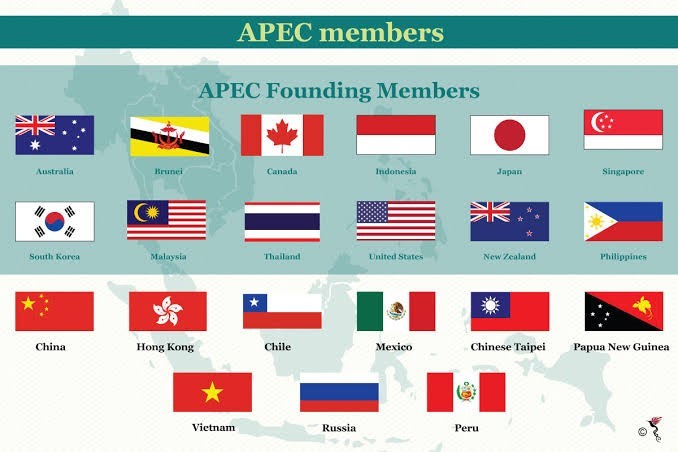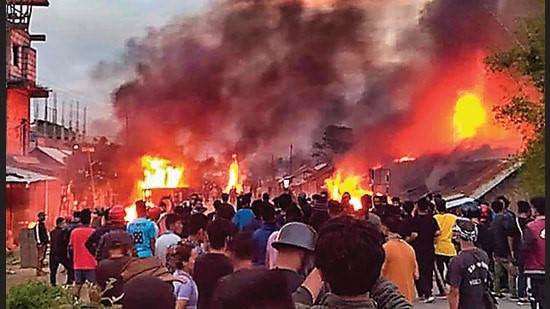Asia-Pacific Economic Cooperation (APEC) and India
Context:
- The Asia-Pacific Economic Cooperation (APEC) Leaders’ Week is now taking place in San Francisco.
- This week-long event brings together political and business leaders from around the Asia-Pacific region to discuss critical economic and trade concerns.
- In spite of the fact that it is not an APEC member, India is taking part in the meeting.
A Brief Introduction to the Asia-Pacific Economic Cooperation (APEC)
- The Asia-Pacific Economic Cooperation (APEC) was created in 1989 as a regional economic conference with the purpose of fostering greater economic integration and prosperity throughout the Asia-Pacific region.
- It is comprised of 21 member economies, which are referred to as “economies” because of their concentration on commercial and financial issues.
Member Economies:
Australia, Brunei, New Zealand, Papua New Guinea, Hong Kong (as part of China), Hong Kong (as part of China), the Philippines, Indonesia, Malaysia, Vietnam, Singapore, Thailand, Chinese Taipei (Taiwan), China, Japan, South Korea, Russia, Canada, the United States, Mexico, Peru, and Chile are all member economies of APEC.
These countries are strategically located around the Pacific Ocean.
The Function of APEC Over the Years
- The Asia-Pacific Economic Cooperation (APEC) has long been a staunch supporter of free trade, as well as the lowering of trade tariffs and the liberalisation of economies.
- The 1991 Seoul Declaration established the construction of a liberalised free trade area across the Pacific Rim as the principal purpose of the Asia-Pacific Economic Cooperation (APEC) organisation.
- Economic Impact The actions of APEC have considerably contributed to the growth of a middle class in the Asia-Pacific region, which has had a positive impact on the area’s economy.
- As of 2018, APEC economies, which have a combined population of 2.9 billion people, are responsible for nearly 60 percent of the world’s GDP and 48 percent of the world’s commerce.
The Role That India Plays in APEC
- Historical Significance: In 1991, when economic reforms for liberalisation and globalisation were first being implemented, India voiced its desire to become a member of the Asia-Pacific Economic Cooperation (APEC).
- To explain: India’s participation in the Asia-Pacific Economic Cooperation (APEC) forum is motivated by a number of factors, including the potential size of its economy, its geographical position, and its trading relationships with the Asia-Pacific region.
- Despite India’s enthusiasm, the Asia-Pacific Economic Cooperation (APEC) has maintained an informal ban on growing membership.
- India’s desire in becoming a member of APEC was acknowledged in the US and India Joint Strategic Vision for the Asia-Pacific and Indian Ocean Region in 2015; however, no concrete steps have been taken in this direction.
- Highlights of the Biden-Xi Meeting at the APEC Summit in 2023: An important feature is the meeting that will take place between Vice President Biden of the United States and President Xi Jinping of China.
- Even if it might not have an immediate impact on US-China ties, it does show continued high-level discussions between the two countries.
- The Indo-Pacific Economic Framework (IPEF): The Indo-Pacific Economic Framework (IPEF), which was established after the United States withdrew from the Trans-Pacific Partnership, will be the primary topic of discussion during the summit.
- The IPEF is made up of a total of fourteen countries, including India and Fiji, with the remaining members being APEC members.
The final word
The APEC Summit 2023 will bring together leaders from the Asia-Pacific region to discuss economic and trade concerns. The meeting between Biden and Xi as well as discussions on the IPEF will be among the most important aspects of the summit.
In spite of India’s long-standing involvement in APEC, the organization’s membership expansion continues to be difficult. This highlights the significance of regional economic forums in determining the economic policies and alliances that are implemented on a global scale.
Meitei-Kuki Conflict in Manipur: A Comprehensive Analysis of Socio-Political Roots and Pathways to Peace
Background:
- Tensions between the Meiteis and Kukis in Manipur have once again broken out into violence, putting the decades-long conflict to the surface.
- The start of this episode is unclear, with different stories about what happened in Churachandpur, which is mostly Kuki, and Imphal East District, which is mostly Meitei.
- As the violence grows, the complex social and political issues involved in the conflict need to be looked at in detail in order to find the reasons and possible answers.
Contestation over Ethnic Indigeneity:
Background: –
- Manipur was a princely state under colonial rule. –
- It integrated into the Union of India in October 1949.
- It became a Union Territory in 1956. – It achieved full statehood in 1972.
- Ethnic Indigeneity: – There is ongoing debate and disagreement regarding the ethnic indigeneity of Manipur.
- Ethnic Groups in the State – Meiteis – Nagas – Kukis Ethnic Groups in Manipur Majority Group: Meiteis The Meiteis are the largest ethnic group in Manipur.
- They mainly live in the Imphal valley and the surrounding areas.
- Scheduled Tribes: Nagas and Kukis The Scheduled Tribes in Manipur consist of two main groups: Nagas and Kukis.
- They primarily inhabit the hilly regions of the state.
Emergence of Militant Groups
In Manipur since the 1960s In the 1960s, Manipur has seen the rise of different militant groups.
These groups claim to represent the interests and concerns of various ethnic communities in the region.
Struggle for Separate Homeland: Kukis and Nagas The Kukis and Nagas have been involved in a struggle for a separate homeland.
This pursuit contradicts the Meiteis’ commitment to protecting the state’s territorial integrity.
Security Challenges in Manipur: The Myanmar Border Introduction: Manipur, a region in India, faces significant security challenges due to its extensive border shared with Myanmar. This border is characterised by ungoverned territory and interconnected relationships among militant groups.
Extent of the Border: The border between Manipur and Myanmar is quite extensive, creating a unique security situation for the region. The length of this border contributes to the complexity of managing security in the area.
Ungoverned Territory: One of the key characteristics of the Manipur-Myanmar border is the presence of ungoverned territory. This means that certain areas along the border lack effective governance and control, creating a potential haven for illegal activities and militant groups. Interconnected Relationships: Another factor that adds to the security challenges in Manipur is the interconnected relationships among militant groups spanning the border. These groups often collaborate and support each other, making it difficult to address security concerns in a localised manner.
Heightened Security Challenges: The combination of an extensive border, ungoverned territory, and interconnected militant groups significantly heightens the security challenges faced by Manipur. This requires a comprehensive and coordinated approach to ensure the safety and stability of the region.
Key Issues Contributing to Ethnic Conflicts in Manipur
- Historical Background – Understanding the historical context of Manipur and its diverse ethnic groups. – Examining past events and conflicts that have shaped the current situation.
- Ethnic Diversity – Recognising the presence of multiple ethnic groups in Manipur. – Exploring the differences in language, culture, and identity among these groups.
- Competition for Resources – Analysing the competition for limited resources such as land, water, and natural resources. – Investigating how this competition has fueled tensions and conflicts between ethnic groups.
- Political Marginalization – Highlighting the political marginalisation of certain ethnic groups in Manipur. – Examining how this marginalisation has led to feelings of exclusion and resentment.
- Identity and Autonomy – Discussing the desire for ethnic groups to preserve their distinct identities and autonomy. – Exploring how this aspiration has contributed to conflicts with other groups and the state.
- Historical Griev
Territorial Integrity vs. Demands for a Separate Homeland: A Simplified Perspective
- Contestation Over Indigeneity and Territorial Integrity Background: There has been a prolonged conflict between the Meiteis and Kukis/Nagas in Manipur regarding the state’s territorial integrity.
- The Parties Involved: The Meiteis and Kukis/Nagas are the main groups engaged in this dispute.
- The Issue: The primary point of contention is the territorial integrity of Manipur.
- For several decades, the Meiteis and Kukis/Nagas have been in conflict over the territorial integrity of Manipur.
Uneven Distribution of Resources:
- Violent Clashes Triggered by High Court’s Order: May 3 clashes attributed to High Court’s directive for Manipur to submit ST status recommendations for Meiteis.
- Meiteis seek legal recognition for ownership of land, currently controlled by Nagas and Kukis.
- Fear among Nagas and Kukis that granting ST status to Meiteis would lead to a land monopoly and reinforce political and economic dominance.
Demographic Disparities:
- Meiteis, comprising over 50% of Manipur’s population, categorized as unreserved or OBC.
- Kukis and Nagas (mostly Christians) are STs, constituting around 40% of the population.
- Meiteis occupy only 10% of Manipur’s total land, while Nagas and Kukis reside in the remaining 90%, fostering narratives of marginalization.
- Land Ownership Restrictions: Legal restrictions prevent Meiteis from buying land in Kuki- and Naga-inhabited areas.
- Grievances since Manipur’s 1949 union with India focus on Meiteis’ lack of rights to protect customs, land, beliefs, and livelihoods.
ST Status Demand by Meiteis:
- STDCM, representing Meiteis, advocates for ST status since 2012.
- Government of India requested Manipur’s recommendation in May 2013; no response by the time of this brief.
- Union government sought a recommendation again on May 31, 2022.
Legal Proceedings:
- Mutum Churamani, a Meitei, petitions High Court for state government response.
- High Court issues order on April 4, 2023, directing the state government to respond within four weeks.
- Government response overshadowed by clashes following the order.
Hill-Valley Divide: Uneven Development and Asymmetric Political Representation
- Hill-Valley Divide and ST Status Demand: Meiteis’ demand for ST status intensifies Hill-Valley divide in Manipur.
- Historical factors, including asymmetric development and political representation, contribute to the divide.
- Economic and political focus on the valley leaves Kukis and Nagas without benefits.
- Valley-Centric Development: Infrastructure development in Manipur predominantly favors the Imphal valley.
- Budget allocations highlight the stark imbalance: INR 21,481 crores for the valley, only INR 419 crores for the hills (2017-2020).
Political Underrepresentation of Hills:
- Hill populations, including Nagas, Kukis, and other tribes (~40% of the population), have 19 seats in the legislative assembly.
- Meiteis, constituting 50% of the population, hold 60 seats.
- Disproportionate representation leaves Kukis and Nagas reliant on Meitei-controlled assembly, regardless of party affiliation.
Dependency and Meitei Assertion:
- Kukis argue that laws and policies, instruments of Meitei assertion into tribal areas, hinder conflict resolution.
- Ongoing conflict seen as unsolvable under the current arrangement due to Meitei dominance.
Scholarly Perspectives on Uneven Development:
Scholars note uneven development in Manipur linked to marginalization.
- Marginalization not solely due to limited political representation but also tied to locality, ethnic status, and history, as reflected in Kuki literature.
- Government response overshadowed by clashes following the order.
Governance Deficit and Demands for Autonomy:
Lack of Governance:
Insurgency groups set up their own forms of government because they see problems with the current system.
Manipur’s flawed decentralisation makes it harder for hill areas to get justice.
Challenges of decentralisation:
The Hill Areas Committee (HAC) and the Autonomous District Councils (ADCs) don’t have enough power to do their jobs.
ADCs rely on the state government for most of their power.
Group disagreements:
The Nagas are against extending the Sixth Schedule because they see it as getting in the way of their goal of returning to their country.
Legislation Issues: Manipur’s efforts to gain more independence are met with resistance, which makes Kukis unhappy.
Way forward
- Immediate, substantial discussion and confidence-building initiatives are necessary to address the Meitei-Kuki dispute.
- It is critical that militant groups and violent people be disarmed.
- The political will of the state government is crucial to realising these objectives.
- Academics and unbiased persons can play an important role in promoting discussion over antagonism.
- Reconsidering how power is exercised and where resources are allocated can help reduce racial gaps.
- It is possible to correct past injustices by streamlining the membership of legislative assemblies and placing more emphasis on decentralisation and autonomy.
- Long-term stability requires starting conversations about land ownership and fair development.
- It is essential to instill a sense of brotherhood among different ethnic groups.
- Making policy should be about more than just winning elections; it should be about establishing a strong country.
More long-lasting results may be achieved when issues are resolved through social platforms rather than only through governmental channels.
Growth dichotomy
Context:
The deceleration in the expansion of industrial output indicates a decline in consumer confidence.
Sluggish Industrial Expansion:
- Lackluster Industrial Output Growth: In September, the Industrial Production Index (IIP) recorded a growth of 5.8%, witnessing a significant deceleration from the preceding month’s 10.3%, falling short of the expected range of 7% to 8%.
- Economic Gauge: The IIP serves as a crucial economic gauge, disclosing a worrisome pattern of sluggish industrial output and reflecting challenges in the overall economic panorama.
- Concerns and Anticipations: The subdued growth in IIP raises apprehensions regarding the momentum of industrial activities, falling below the predictions of economists. This prompts a thorough examination of the factors contributing to the slowdown and the broader economic consequences.
Diverse Sectoral Issues:
- Sectoral Constrictions and Inventory Challenges: In September, nine manufacturing sectors, including furniture and apparel production, experienced contractions. Hopes for pre-festive season inventory buildup were dashed.
- Diminished Consumer Confidence: Consumer confidence remains low, with minimal growth observed in both consumer durables and non-durables. Fast-moving consumer goods registered a 3.5% decline, indicating restrained spending patterns.
- Economic Disparity and Resilience: The IIP underscores an economic asymmetry, with sectors linked to investments demonstrating resilience. This is in stark contrast to the challenges faced by consumer-centric segments, underscoring the necessity for well-balanced economic recovery strategies.
Economic Discrepancy and Future Obstacles:
- Economic Disparity and Q2 Performance: The second quarter witnessed an average factory output growth of 7.4%, aligning with the expectations for Q2 GDP growth set by the central bank. This highlights economic disparities.
- Consumer versus Investment Sectors: Consumer goods, particularly durables, lag behind pre-COVID-19 levels, contrasting with the resilient growth in sectors tied to investment, such as infrastructure and construction goods.
Challenges and Future Prospects: Challenges on the horizon include the potential moderation in capital expenditure, uncertainties in sensitive commodity prices, and a decline in output related to infrastructure and construction goods. This emphasizes the crucial role of consumption in the economic landscape.
What are Active and Passive Equity Funds?
- Mutual fund investors are currently favouring active equity funds over passive funds, according to a recent study.
Active Funds | Passive Funds |
They are managed by a fund manager who actively buys and sells securities to achieve the fund’s objective. | They track a benchmark index and try to replicate its performance by investing in securities in the same proportion as in the index. |
They aim to beat the benchmark and generate higher returns than the index. | They aim to match the benchmark and deliver returns similar to the index, subject to expense ratio and tracking error. |
They have a higher expense ratio due to the active involvement of the fund manager and higher portfolio turnover. | They have a lower expense ratio due to the passive nature of the fund and lower portfolio turnover. |
They may be more volatile and risky depending on the fund manager’s strategy and the type of fund. | They eliminate unsystematic risk by following a rule-based investing approach and diversifying across the index constituents. |
They may offer more flexibility and opportunities to the fund manager to exploit market inefficiencies and capitalize on changing market conditions. | They offer more transparency and consistency to the investors as they follow a predefined index and do not deviate from it. |




